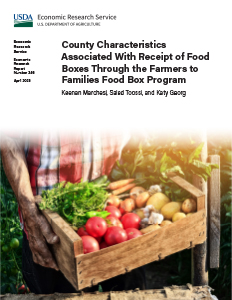County Characteristics Associated With Receipt of Food Boxes Through the Farmers to Families Food Box Program
- by Keenan Marchesi, Saied Toossi and Katy Georg
- 4/9/2025
Overview
The economic recession induced by the onset of the Coronavirus (COVID-19) pandemic in March 2020 contributed to an increase in food hardship for millions of people. To help alleviate this hardship, USDA created the temporary Farmers to Families Food Box Program. Through this program, USDA contracted with producers, processors, and distributors to package agricultural commodities produced in the United States into boxes (hereafter “food boxes”) for delivery to nonprofit organizations (e.g., food banks and pantries) for distribution to people in need. However, evidence about whether and to what extent the program was able to reduce food hardship is limited. This report used administrative and survey data to examine whether counties characterized by greater levels of need (based on measures of their food environment, food access, rates of food hardship, economic conditions, demographic composition, and urbanicity) were more likely to receive food boxes. The program delivered 177.6 million food boxes from May 2020 through May 2021. Counties with larger populations and higher unemployment rates were more likely to receive food boxes throughout the program’s operation, as were more metropolitan counties and those with higher poverty rates and shares of non-Hispanic Black and Hispanic populations in round 5.
How to Cite:
Marchesi, K., Toossi, S., & Georg, K. (2025). County characteristics associated with receipt of food boxes through the Farmers to Families Food Box Program (Report No. ERR-346). U.S. Department of Agriculture, Economic Research Service. https://doi.org/10.32747/2025.9015822.ers
Download
-
Entire report
Download PDF -
Report summary
Download PDF

